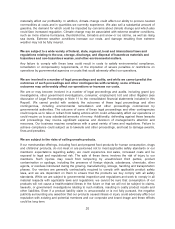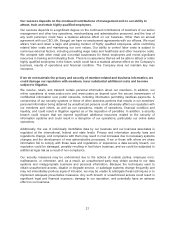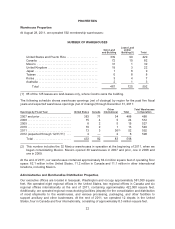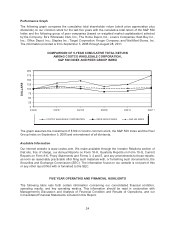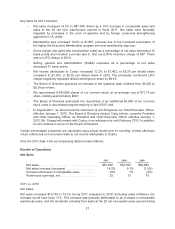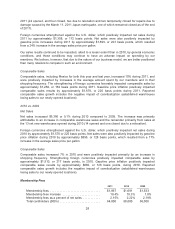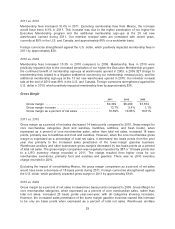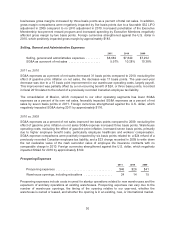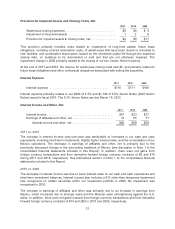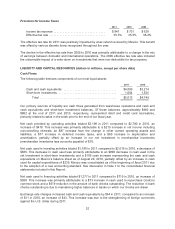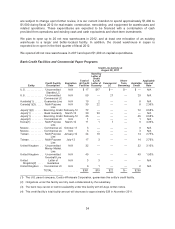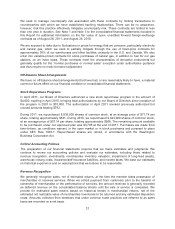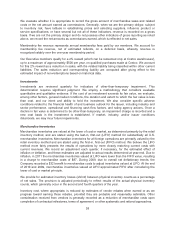Costco 2011 Annual Report Download - page 31
Download and view the complete annual report
Please find page 31 of the 2011 Costco annual report below. You can navigate through the pages in the report by either clicking on the pages listed below, or by using the keyword search tool below to find specific information within the annual report.
2011 vs. 2010
Membership fees increased 10.4% in 2011. Excluding membership fees from Mexico, the increase
would have been 8.3% in 2011. This increase was due to the higher penetration of our higher-fee
Executive Membership program and the additional membership sign-ups at the 20 net new
warehouses opened during 2011. Our member renewal rates are consistent with recent years,
currently at 89% in the U.S. and Canada, and approximately 86% on a worldwide basis.
Foreign currencies strengthened against the U.S. dollar, which positively impacted membership fees in
2011 by approximately $30.
2010 vs. 2009
Membership fees increased 10.3% in 2010 compared to 2009. Membership fees in 2010 were
positively impacted due to the increased penetration of our higher-fee Executive Membership program,
the continued benefit of membership sign-ups at warehouses opened in 2009, a 2009 $27 charge to
membership fees related to a litigation settlement concerning our membership renewal policy, and the
additional membership sign-ups at the 13 net new warehouses opened in 2010. Our member renewal
rate at the end of 2010 was 88% in the U.S. and Canada. Foreign currencies strengthened against the
U.S. dollar in 2010, which positively impacted membership fees by approximately $36.
Gross Margin
2011 2010 2009
Gross margin ................................... $9,309 $8,260 $7,554
Gross margin increase ............................ 12.7% 9.4% 1.1%
Gross margin as a percent of net sales .............. 10.69% 10.83% 10.81%
2011 vs. 2010
Gross margin as a percent of net sales decreased 14 basis points compared to 2010. Gross margin for
core merchandise categories (food and sundries, hardlines, softlines, and fresh foods), when
expressed as a percent of core merchandise sales, rather than total net sales, increased 18 basis
points, primarily due to hardlines and food and sundries. However, when the core merchandise gross
margin is expressed as a percentage of total net sales, it decreased two basis points from the prior
year due primarily to the increased sales penetration of the lower-margin gasoline business.
Warehouse ancillary and other businesses gross margins decreased by two basis points as a percent
of total net sales. The gross margin comparison was negatively impacted by $87 or 10 basis points due
to a LIFO inventory charge recorded in 2011. The charge resulted from higher costs for our
merchandise inventories, primarily food and sundries and gasoline. There was no LIFO inventory
charge recorded in 2010.
Excluding the impact of consolidating Mexico, the gross margin comparison as a percent of net sales
would have been a decrease of 18 basis points during 2011. Foreign currencies strengthened against
the U.S. dollar, which positively impacted gross margin in 2011 by approximately $149.
2010 vs. 2009
Gross margin as a percent of net sales increased two basis points compared to 2009. Gross Margin for
core merchandise categories, when expressed as a percent of core merchandise sales, rather than
total net sales, increased 25 basis points year-over-year, with all categories showing increases.
However, the increased sales penetration of the lower margin gasoline business caused this increase
to be only six basis points when expressed as a percent of total net sales. Warehouse ancillary
29



